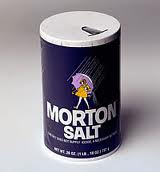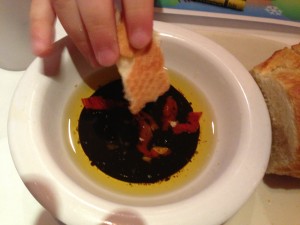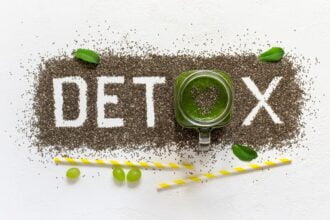Taste buds in your guts? Yes. And cats…they can’t taste sweet. Taste buds are not just found in the tongue, but throughout the entire GI tract, and even the lung! Taste buds throughout our body don’t all function to provide a sense of taste but are used to trigger other reactions. In the tongue, they provide a sense of taste that drives us to seek some foods and to avoid others. Taste may have evolved as one of the primary mechanism to seek foods that have nutritional value.
Taste buds in your guts? Yes. And cats…they can’t taste sweet. Taste buds are not just found in the tongue, but throughout the entire GI tract, and even the lung! Taste buds throughout our body don’t all function to provide a sense of taste but are used to trigger other reactions. In the tongue, they provide a sense of taste that drives us to seek some foods and to avoid others. Taste may have evolved as one of the primary mechanism to seek foods that have nutritional value.
This is a review of the tastes, and some other places where those tastes are sensed, and how we use them in food and to regulate our body.
Myth: The tongue has certain regions that detect specific tastes: Years ago there was the theory that different regions of the tongue detected specific tastes- but that tongue map was incorrect. One can taste the bitter, sour, sweet, and salty throughout the tongue.
BITTER
Bitter is the most sensitive of the tastes, the classic biter taste is quinine (think tonic water). Bitter is generally associated with helping us avoid toxins. When the stomach taste bud gets something bitter it triggers reactions that slows down digestion, keeping the “bad food” in the stomach. Eat some bad shellfish, while they may not “taste” bad to your tongue, the bitter buds in the stomach will sense them. The taste bud sends a signal to stop the muscles of the stomach from pushing the bad food past your stomach and then trigger a center in your brain for nausea. Once you regurgitate the bad food, and the stomach no longer senses that bitter taste, the signal to the brain stops, and you no longer have nausea. Somewhere in your brain, as you recover from the bad shellfish, a memory is linked and it is unlikely you will eat shellfish in that form again (be it a bad clam, or restaurant, or city).
Not all bitter is a bad thing. On a hot day a refreshing gin and tonic is delicious. The bitterness of the tonic evoking some good memories. But gin and tonic is more than just another drink. Gin and tonic replaced the classic afternoon tea in the British Empire, especially in the colonies where there was malaria. Quinine (tonic) was a potent anti-malarial drug for years, until the parasites became resistant to it. So the afternoon tonic really was medicine. Todays tonic water has much less quinine than used in the past.

Coffee has a bitter flavor that supertasters find noxious. Clearly my son has no problem enjoying coffee
Coffee, tea, wine , pickles, stout beer, juju beans, rhubarb, unsweetened chocolate- all contain elements of bitter, and all of those elements allow us to enjoy some great foods. For those who enjoy a great Manhattan, the adding of “bitters”- makes the drink perfect. Bitters are herbs infused with alcohol – such as sarsaparilla cassia, wild cherry bark, and others which used to be sold as medicine, but were discovered to add depth to drinks. Modern artesian bartenders make their own bitters, although you purchase them at liquor stores.
Bitter also distinguishes people who are called super tasters. They can taste a highly bitter ingredient that most people cannot detect. Being a super taster does not mean having the ability to appreciate more foods, but rather fewer foods. Super tasters find many bitter ingredients unpalatable, be it coffee, wine, or some other foods. While these supertasters do not enjoy great coffee, they do have one advantage – the bitter taste buds in their sinus area produce a strong reaction against bacteria and rarely get sinus infections.
SWEET
Sweet is the taste of sugar. People easily become accustomed to more sweetness. To balance the sweet, people end up eating more savory or salty foods. Colas have a lot of salt, and a lot of sweet. The sweet masks the salt, and the salt is designed to get you to want to drink more.
Cats don’t have the taste for sweets – it is thought that one of the reasons that cats developed a taste for meat, which was not good for the local population of mice or birds. Many cat foods contain carbohydrates, some as much as 20% which the cats can not taste, but their systems are not designed for those sweets. This sometimes drives the house cat to seek more savory items, like birds. Cats are such efficient predators, that they have been classified as an invasive species, and have threatened wildlife in Florida, Hawaii, and other places. Some of this is simply their taste driving them to eat, and part because the cat food commonly sold will not satisfy them, and may even harm them (one reason some domestic cats develop diabetes).
But when the taste bud in the intestine detects sweets it sends a signal to the pancreas to release insulin. There are also cells that actively transport glucose (a part of sugar that our body uses for fuel) into the bloodstream. When the intestinal taste bud senses the sweetness, it also signals those cells to turn on so they can transport glucose more efficiently. We use to think it was glucose in the bloodstream that started the cycle of insulin production, but adding glucose directly to the bloodstream (like most intravenous solutions) does not initiate the signal as quickly as the taste buds in the intestine.
The glycemic index, a measurement of glucose response to various foods, is determined not by the amount of glucose in the food (bread has a higher response than pure glucose) but by the sweetness that the stomach and intestines sense in the taste buds.
Fructose, while sweet (the other half of the table sugar molecule) does not turn on the insulin response, although since it is often paired with glucose, as in table sugar or high fructose corn syrup. But fructose does blunt the response of insulin, and since insulin is one of the signals that tells you that you have eaten enough , fructose can drive people to eat more food. While Paleo diet people think bread is the problem with diets, because of its increased glycemic response, it is really the fructose, in its refined form (table sugar, high fructose corn syrup) that is more of the issue.
SALT
Salty flavor is classic table salt, or sodium chloride.
Placing salt on meats before they are cooked is called seasoning. This does not lead to a salty flavor. Seasoning salt makes the surface of the meat prime for chemical reactions of heat, providing great smells and textures (this is known as the Maillard reaction). Adding salt after the cooking process is what leads to the salty flavor and can be overdone—salty food isn’t good; seasoned food is.

In most cooking stores you can purchase four basic salts: common table salt, kosher salt, sea salt, and fleur de sel. Some salts vary in color because they are gathered from tidal pools with algae. The main ingredient in all of these salts is the chemical sodium chloride. Salts range in price from pennies per ounce to dollars per ounce. While the crystal shapes of these salts are different, in blind taste tests most people can tell no difference between them. Many cooks use kosher salt to season meats and poultry; a touch of sea salt on cooked vegetables; and the fine fleur de sel as a finishing salt on some dishes. Kosher salt is used for seasoning because of its size, shape, and it is inexpensive. If you do not season meats with salt, then the taste of the meat becomes quite bland.
Seasoning, or salting the meat before cooking, dries the surface of the meat. When that surface is then placed against a high heat there is a nice crust that is formed, and many of the delicious smells of the meats come out. Try this: make two small hamburgers on a grill – with one season with salt and pepper before grilling. With the other, just place it on the grill. Taste both- you will like the seasoned meat much better. Same with chicken, lamb, and all meats.
Because some people must limit salt for health reasons, a number of salt substitutes have been developed. Lithium salts and potassium salts taste like table salt and have been used as salt substitutes. Lithium was found to have an effect on the brain and now lithium is a mainstay in the treatment of bipolar disorder. Too much salt is not healthy. But you need salt to live, and you need salt for flavor. Poor-quality restaurants (most chains) and most convenience foods contain more salt than is found in recipes in common recipe books.
SOUR
Sour is the taste found in vinegar, lemons, limes, and pickles. Sour taste evolved to protect us against many spoiled foods. Although learning to preserve foods often involves a sour taste. Kim Chi has a potent sour taste, but the ability to preserve cabbage allowed people on the Korean peninsula to survive harsh winters. Learning to love that sour taste is a part of adaptation of the sensory system.
Sour detects “acidic” foods, but those taste buds are also found in the spine where they help regulate the pH of spinal fluid.
Sour candy, sweet tarts, skittles, all contain citric acid that produce a burst of sour flavor on the tongue. Some elements of bitter are found with sour – and that is because when most items become bitter (as they age) get more acidic. Vinegar is sour because it started out as grape juice, but as the bacteria or yeast used the glucose as fuel, they converted it to a mild acid. The detection of sour can be a good thing, as it is in cheese, candy, pickles, or a bad thing- as when milk has gone sour. Sour provides an early detection of “bad bacteria” or an early detection that the balsamic vinegar is perfect.
The ability to detect the differences was key to survival to early man.
SAVORY or UNAMI

There is no Italian Restaurant Syndrome, and yet more MSG is found in Italian food than Chinese food
Savory is the flavor of meats and soy sauce. A good steak or great mushrooms have a deep savory flavor. MSG is the classic savory flavor. Much maligned, it is MSG that gives the savory flavor to Doritos, parmesan cheese, and tomatoes. There is more MSG in Italian food than Chinese food, but you don’t hear about an “Italian Food Syndrome.” While Chinese Restaurant Syndrome is not caused by MSG, most people it is still in the popular press. I discuss MSG in a previous article.
BALANCE
With taste one needs balance. Anything that has too much of one taste will overwhelm and make the dish uninteresting. When you watch judging of dishes made by chefs on TV shows, like Chopped, Top Chef, or Iron Chef – you will hear the judges refer to a “balance” in the dish. This means that the elements of the dish do not overwhelm with one of the tastes. If you have a sweet element, it is balanced with a bit of salt, or if you have a sour element there is a savory element.
Coca-cola has elements of sweet, salt, and sour – providing a balance of flavors, that makes it go well with a hamburger (savory).
You will also fill up fast when you only use one taste sensation. This is the basis for many diets: You tire of that taste and thus you eat less. Anyone who tries the Atkins diet is likely to tire of savory dishes (people who didn’t think they would ever get tired of eating steak, do). The ice cream diet, the salami diet, the cookie diet, all of those diets which sound good to start with, end up overwhelming the palate with a single flavor (one note ) and you eat less as time goes on.
When cooking dishes, having a balance on the plate provides a great meal. Think of bread and dipping it in a combination of olive oil, balsamic vinegar, with some sardines. The sardines provide salt, the balsamic both sour and bitter, and olive oil the savory – with the bread providing the sweet. A perfect balance.

Olive oil, balsamic vinegar, sardines all provide elements of taste – the sour, salty, and savory, combine with bread- the sweet and you have a perfect balance










